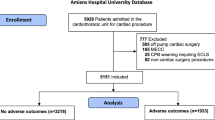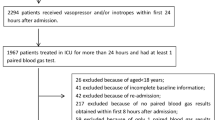Abstract
Objective
Blood O2 saturation and lactate concentration gradients from superior vena cava (SVC) to pulmonary artery (PA) occur in critically ill patients. These gradients (ΔSO2 and Δ[Lac]) may be positive or negative. We tested the hypothesis that positive ΔSO2 and Δ[Lac] are associated with improved survival in critically ill patients.
Design and setting
Multinational, prospective observational study conducted in six medical and surgical ICUs.
Patients
Consecutive sample of 106 adults requiring insertion of a pulmonary artery catheter (PAC). Average age was 59.5 ± 15.5 years, APACHE II score was 15.5 ± 6.7 (mean ± SD). Main outcome measure was 28-day mortality.
Interventions
None.
Measurements and results
We drew blood samples from the proximal and distal ports of PACs every 6 h from the time of PAC insertion (Initial measurement) until its removal (Final measurement). Samples were analyzed for SO2, [Lac], glucose concentration and blood gases. Hemodynamic measurements were obtained after blood samples. We monitored patients for 30.9 ± 11.0 h. Overall mortality rate was 25.5%. More survivors had mean and final ΔSO2 ≥ 0 and Δ[Lac] ≥ 0 than decedents (p < 0.01; p < 0.05 respectively). On the average, ΔSO2 and Δ[Lac] were positive in survivors and negative in decedents. Survival odds ratios for final measurements of ΔSO2 ≥ 0 and Δ[Lac] ≥ 0 were 19.22 and 7.70, respectively (p < 0.05).
Conclusions
A strong association exists between positive ΔSO2 and Δ[Lac] and survival in critically ill patients. Whether therapy aimed at increasing ΔSO2 and Δ[Lac] results in improved ICU survival remains to be determined.



Similar content being viewed by others
References
Edwards JD, Mayall RM (1998) Importance of the sampling site for measurement of mixed venous oxygen saturation in shock. Crit Care Med 26:1356–1360
Chawla LS, Zia H, Gutierrez G, Katz NM, Seneff MG, Shah M (2004) Lack of equivalence between central and mixed venous oxygen saturation. Chest 126:1891–1896
Dueck MH, Klimek M, Appenrodt S, Weigand C, Boerner U (2005) Trends but not individual values of central venous oxygen saturation agree with mixed venous oxygen saturation during varying hemodynamic conditions. Anesthesiology 103:249–257
Varpula M, Karlsson S, Ruokonen E, Pettilä V (2006) Mixed venous oxygen saturation cannot be estimated by central venous oxygen saturation in septic shock. Intensive Care Med 32:1336–1343
Gutierrez G, Chawla LS, Seneff MG, Katz NM, Zia H (2005) Lactate concentration gradient from right atrium to pulmonary artery. Crit Care 2005:R425–R429
Reinhart K, Kuhn HJ, Hartog C, Bredle DL (2004) Continuous central venous and pulmonary artery oxygen saturation monitoring in the critically ill. Intensive Care Med 30:1572–1578
Rivers E (2006) Mixed vs. Central venous oxygen saturation may not be numerically equal, but both are still clinically useful. Chest 129:507–508
Lee J, Wright F, Barber R, Stanley L (1972) Central venous oxygen saturation in shock: a study in man. Anesthesiology 36:472–478
Gutierrez G, Venbrux A, Ignacio E, Reiner J, Chawla L, Desai A (2007) The concentration of oxygen, lactate and glucose in the central veins, right heart, and pulmonary artery: a study in patients with pulmonary hypertension. Crit Care 11:R44
Court O, Kumar A, Parrillo JE, Kumar A (2002) Clinical review: myocardial depression in sepsis and septic shock. Crit Care 6:500–508
Vánky FB, Håkanson E, Tamás E, Svedjeholm R (2006) Risk factors for postoperative heart failure in patients operated on for aortic stenosis. Ann Thorac Surg 8:1297–1304
Knaus WA, Draper EA, Wagner DP, Zimmerman JE (1985) APACHE II: a severity of disease classification system. Crit Care Med 13:818–829
Bone RC, Balk RA, Cerra FB, Dellinger RP, Fein AM, Knaus WA, Schein RM, Sibbald WJ (1992) Definitions for sepsis and organ failure and guidelines for the use of innovative therapies in sepsis. The ACCP/SCCM Consensus Conference Committee. American College of Chest Physicians/Society of Critical Care Medicine. Chest 101:1644–1655
Vittinghoff E (2004) Regression methods in biostatistics: linear, logistic, survival, and repeated measures models (Statistics for Biology & Health Series). Springer, New York, pp 180–268
Zar JH (1999) Simple linear correlation. In: Biostatistical analysis, 4th edn. Prentice-Hall, Upper Saddle River, pp 377–383
Holm SA (1979) A simple sequentially rejective multiple test procedure. Scand J Statistics 6:65–70
Bewick V, Cheek L, Ball J (2004) Statistics review 13: receiver operating characteristic curves. Crit Care 8:508–512
Hanley JA, McNeil BJ (1983) A method of comparing the areas under receiver operating characteristic curves derived from the same cases. Radiology 148:839–843
Gutierrez G, Bismar H, Dantzker DR, Silva N (1992) Comparison of gastric intramucosal pH with measures of oxygen transport and consumption in critically ill patients. Crit Care Med 20:R451–R457
Sander M, Spies CD, Foer A, Weymann L, Braun J, Volk T, Grubitzsch H, von Heymann C (2007) Agreement of central venous saturation and mixed venous saturation in cardiac surgery patients. Intensive Care Med 33:1719–1725
Reinhart K, Bloos F (2005) The value of venous oximetry. Curr Opin Crit Care 11:259–263
Dellinger RP, Levy MM, Carlet JM, Bion J, Parker MM, Jaeschke R, Reinhart K, Angus DC, Brun-Buisson C, Beale R, Calandra T, Dhainaut JF, Gerlach H, Harvey M, Marini JJ, Marshall J, Ranieri M, Ramsay G, Sevransky J, Thompson BT, Townsend S, Vender JS, Zimmerman JL, Vincent JL (2008) Surviving sepsis campaign: international guidelines for management of severe sepsis and septic shock: 2008. Intensive Care Med 34:17–60
Acknowledgments
Funds to conduct this research were provided by internal research grants from the various participating institutions and by a Research Grant from The Richard B. and Lynne V. Cheney Cardiovascular Institute. The authors thank Dr. Subrata Kundu and Mr. Hiro Hikawa, Department of Statistics, The George Washington University for their assistance in data analysis.
Dr. Gutierrez holds a patent application on a method related to the subject matter of the study. No other author has conflicts of interest to declare.
Author information
Authors and Affiliations
Corresponding author
Electronic supplementary material
Rights and permissions
About this article
Cite this article
Gutierrez, G., Comignani, P., Huespe, L. et al. Central venous to mixed venous blood oxygen and lactate gradients are associated with outcome in critically ill patients. Intensive Care Med 34, 1662–1668 (2008). https://doi.org/10.1007/s00134-008-1128-2
Received:
Accepted:
Published:
Issue Date:
DOI: https://doi.org/10.1007/s00134-008-1128-2




